CHRYSLER CROSSFIRE 2008 1.G Owners Manual
Manufacturer: CHRYSLER, Model Year: 2008, Model line: CROSSFIRE, Model: CHRYSLER CROSSFIRE 2008 1.GPages: 358, PDF Size: 4.7 MB
Page 261 of 358
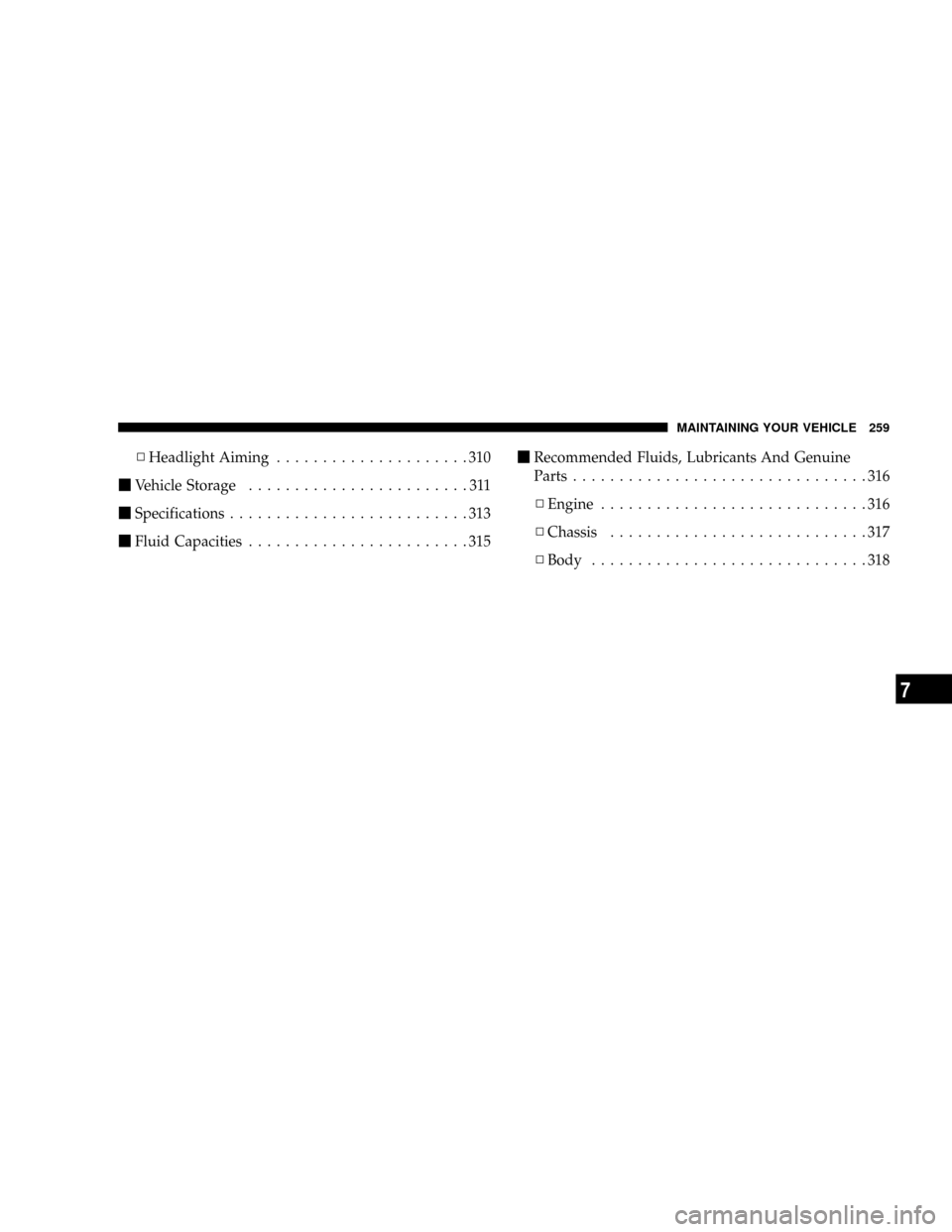
NHeadlight Aiming.....................310
mVehicle Storage........................311
mSpecifications..........................313
mFluid Capacities........................315mRecommended Fluids, Lubricants And Genuine
Parts................................316
NEngine.............................316
NChassis............................317
NBody..............................318
MAINTAINING YOUR VEHICLE 259
7
Page 262 of 358
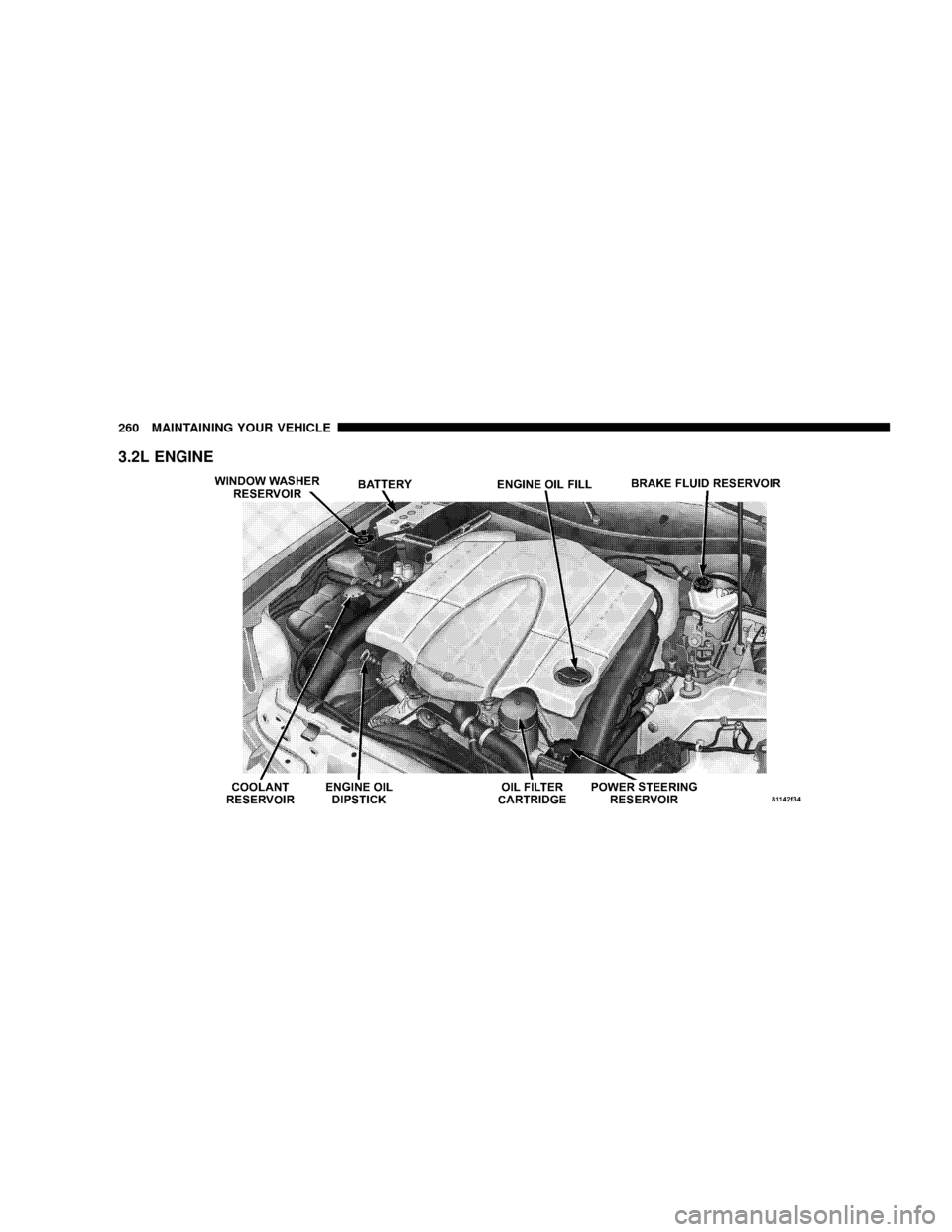
3.2L ENGINE
260 MAINTAINING YOUR VEHICLE
Page 263 of 358
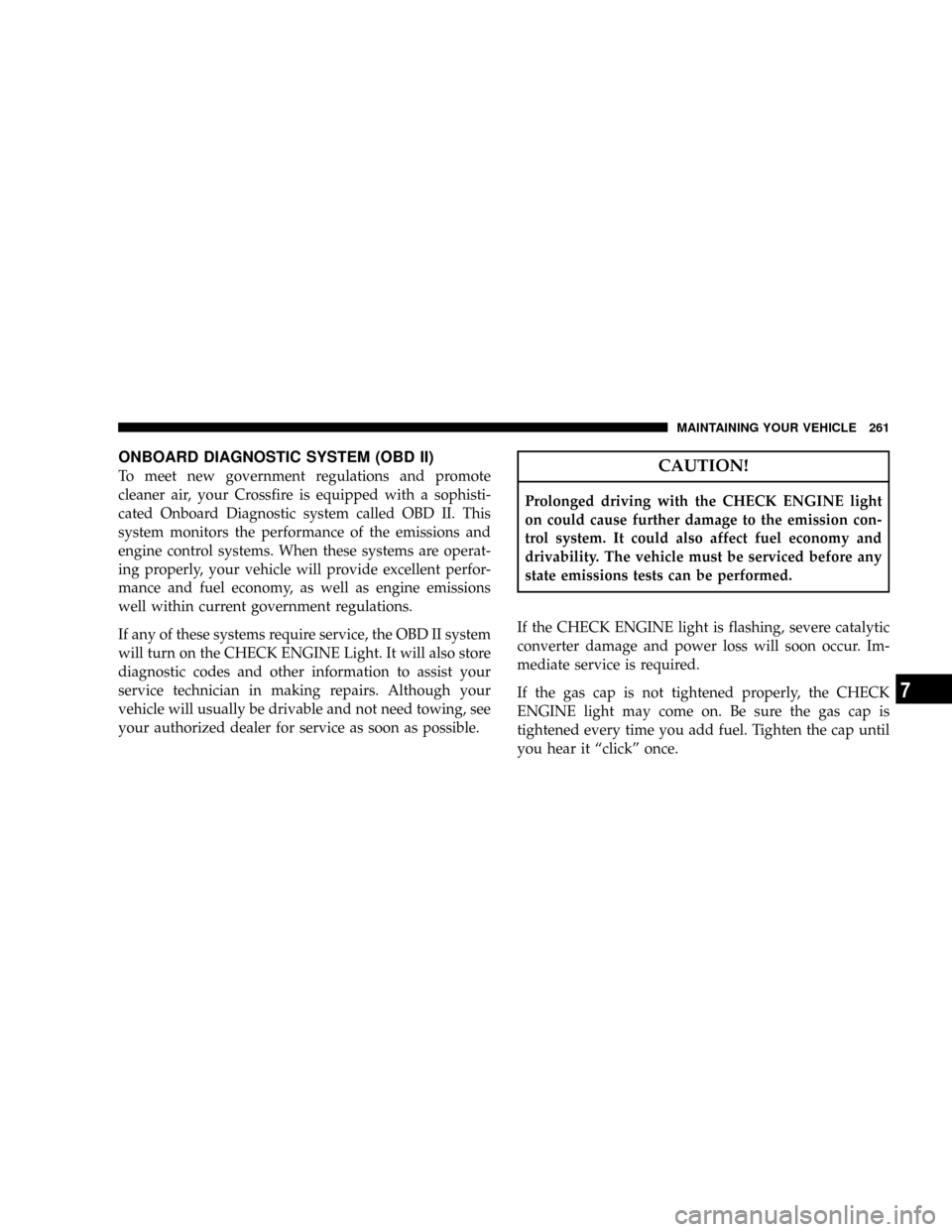
ONBOARD DIAGNOSTIC SYSTEM (OBD II)
To meet new government regulations and promote
cleaner air, your Crossfire is equipped with a sophisti-
cated Onboard Diagnostic system called OBD II. This
system monitors the performance of the emissions and
engine control systems. When these systems are operat-
ing properly, your vehicle will provide excellent perfor-
mance and fuel economy, as well as engine emissions
well within current government regulations.
If any of these systems require service, the OBD II system
will turn on the CHECK ENGINE Light. It will also store
diagnostic codes and other information to assist your
service technician in making repairs. Although your
vehicle will usually be drivable and not need towing, see
your authorized dealer for service as soon as possible.CAUTION!
Prolonged driving with the CHECK ENGINE light
on could cause further damage to the emission con-
trol system. It could also affect fuel economy and
drivability. The vehicle must be serviced before any
state emissions tests can be performed.
If the CHECK ENGINE light is flashing, severe catalytic
converter damage and power loss will soon occur. Im-
mediate service is required.
If the gas cap is not tightened properly, the CHECK
ENGINE light may come on. Be sure the gas cap is
tightened every time you add fuel. Tighten the cap until
you hear it ªclickº once.
MAINTAINING YOUR VEHICLE 261
7
Page 264 of 358
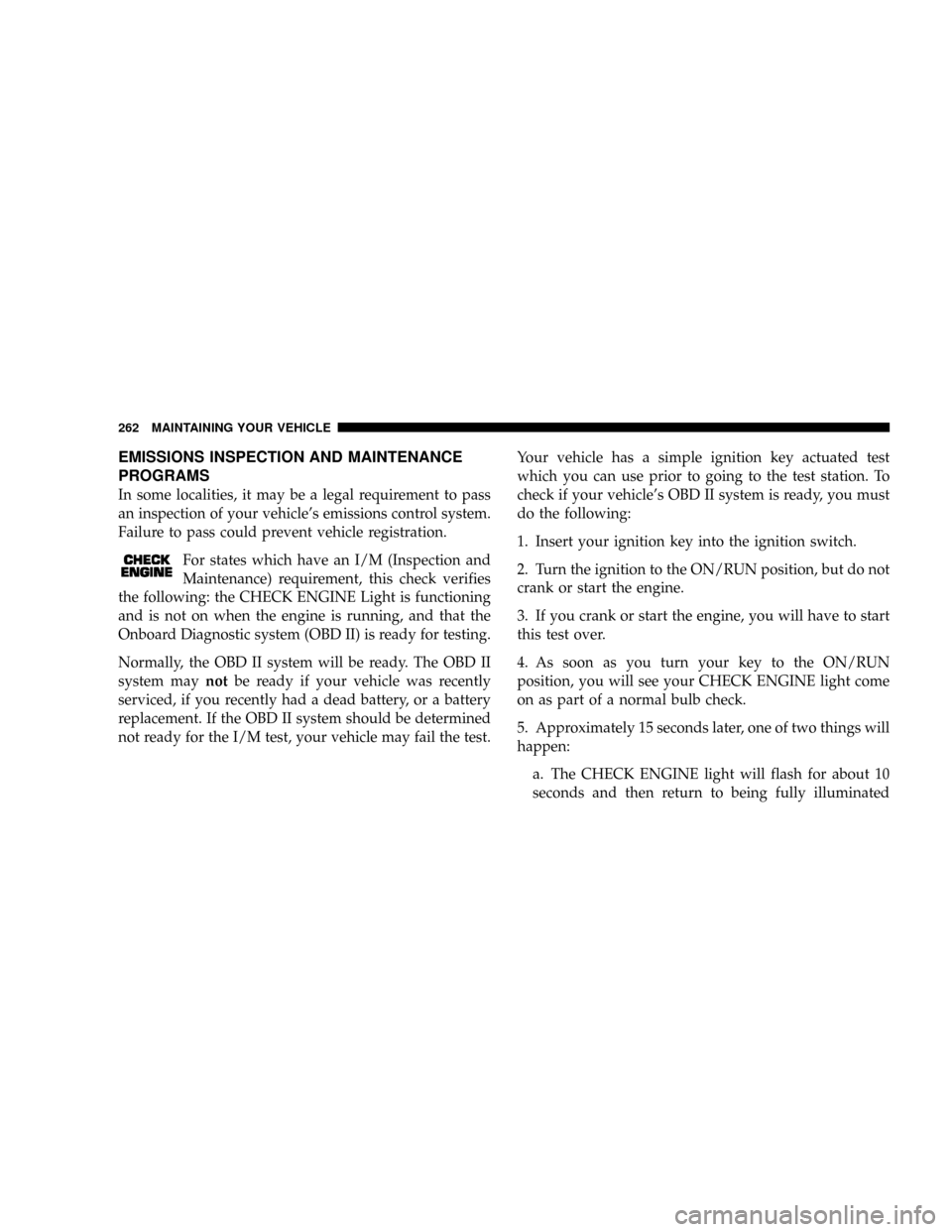
EMISSIONS INSPECTION AND MAINTENANCE
PROGRAMS
In some localities, it may be a legal requirement to pass
an inspection of your vehicle's emissions control system.
Failure to pass could prevent vehicle registration.
For states which have an I/M (Inspection and
Maintenance) requirement, this check verifies
the following: the CHECK ENGINE Light is functioning
and is not on when the engine is running, and that the
Onboard Diagnostic system (OBD II) is ready for testing.
Normally, the OBD II system will be ready. The OBD II
system maynotbe ready if your vehicle was recently
serviced, if you recently had a dead battery, or a battery
replacement. If the OBD II system should be determined
not ready for the I/M test, your vehicle may fail the test.Your vehicle has a simple ignition key actuated test
which you can use prior to going to the test station. To
check if your vehicle's OBD II system is ready, you must
do the following:
1. Insert your ignition key into the ignition switch.
2. Turn the ignition to the ON/RUN position, but do not
crank or start the engine.
3. If you crank or start the engine, you will have to start
this test over.
4. As soon as you turn your key to the ON/RUN
position, you will see your CHECK ENGINE light come
on as part of a normal bulb check.
5. Approximately 15 seconds later, one of two things will
happen:
a. The CHECK ENGINE light will flash for about 10
seconds and then return to being fully illuminated
262 MAINTAINING YOUR VEHICLE
Page 265 of 358
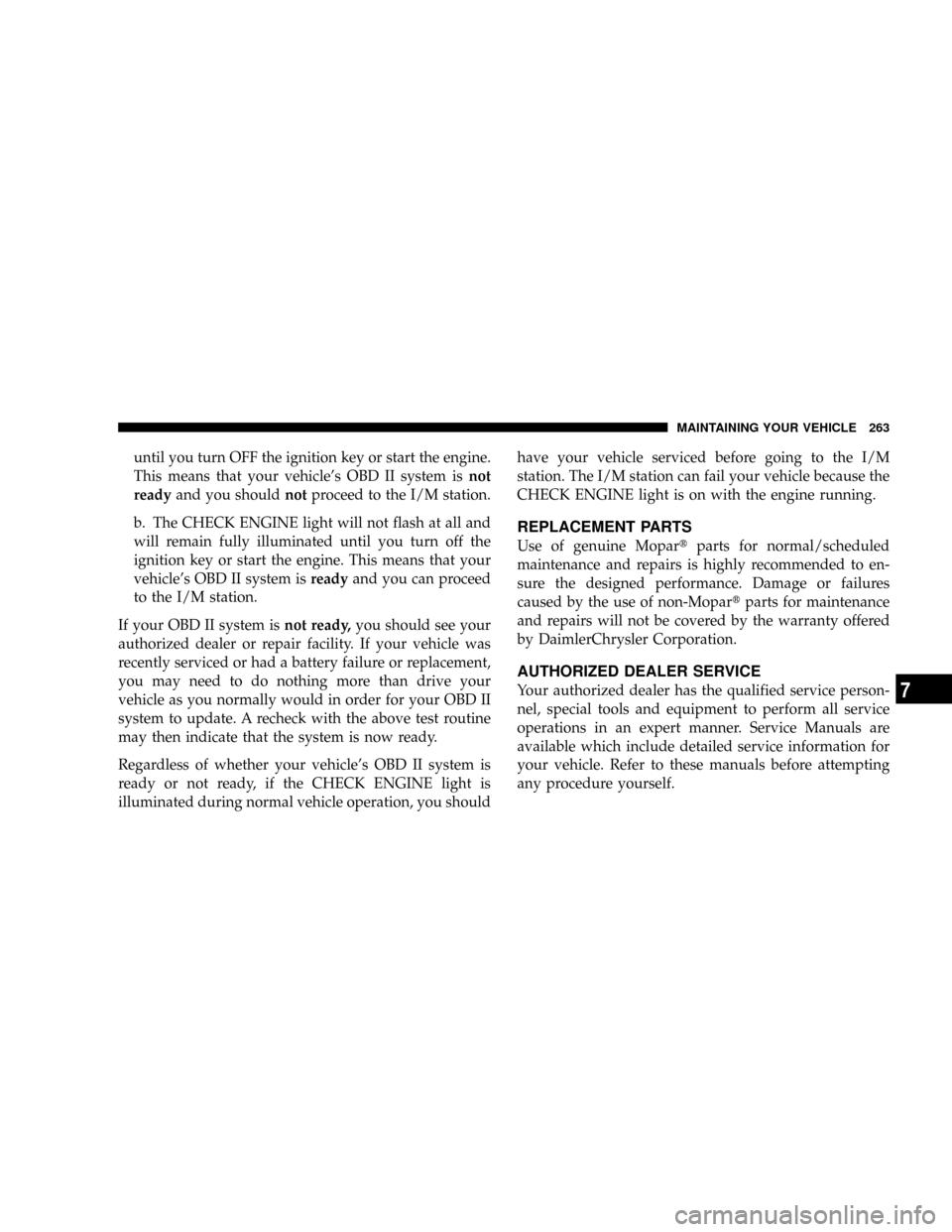
until you turn OFF the ignition key or start the engine.
This means that your vehicle's OBD II system isnot
readyand you shouldnotproceed to the I/M station.
b. The CHECK ENGINE light will not flash at all and
will remain fully illuminated until you turn off the
ignition key or start the engine. This means that your
vehicle's OBD II system isreadyand you can proceed
to the I/M station.
If your OBD II system isnot ready,you should see your
authorized dealer or repair facility. If your vehicle was
recently serviced or had a battery failure or replacement,
you may need to do nothing more than drive your
vehicle as you normally would in order for your OBD II
system to update. A recheck with the above test routine
may then indicate that the system is now ready.
Regardless of whether your vehicle's OBD II system is
ready or not ready, if the CHECK ENGINE light is
illuminated during normal vehicle operation, you shouldhave your vehicle serviced before going to the I/M
station. The I/M station can fail your vehicle because the
CHECK ENGINE light is on with the engine running.
REPLACEMENT PARTS
Use of genuine Mopartparts for normal/scheduled
maintenance and repairs is highly recommended to en-
sure the designed performance. Damage or failures
caused by the use of non-Mopartparts for maintenance
and repairs will not be covered by the warranty offered
by DaimlerChrysler Corporation.
AUTHORIZED DEALER SERVICE
Your authorized dealer has the qualified service person-
nel, special tools and equipment to perform all service
operations in an expert manner. Service Manuals are
available which include detailed service information for
your vehicle. Refer to these manuals before attempting
any procedure yourself.
MAINTAINING YOUR VEHICLE 263
7
Page 266 of 358
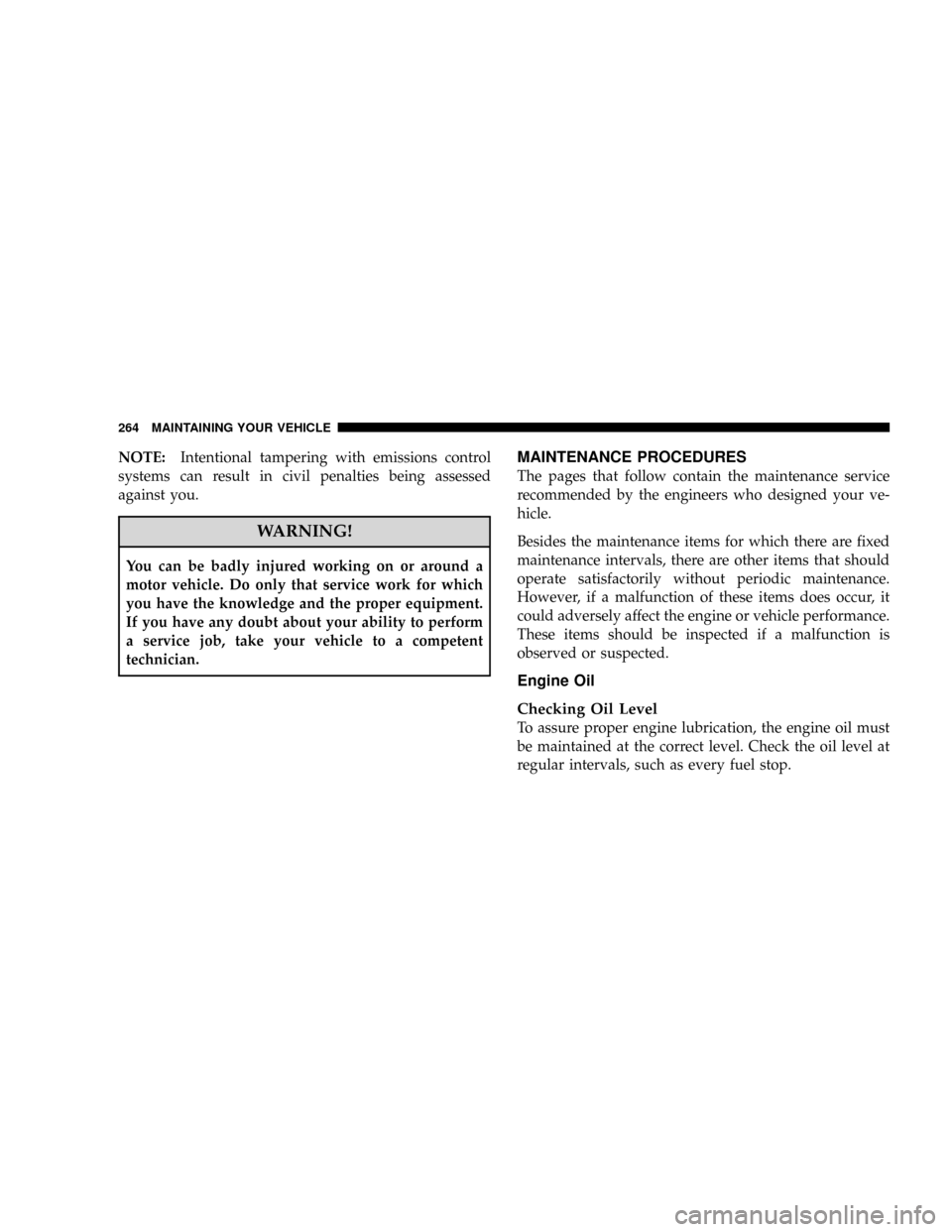
NOTE:Intentional tampering with emissions control
systems can result in civil penalties being assessed
against you.
WARNING!
You can be badly injured working on or around a
motor vehicle. Do only that service work for which
you have the knowledge and the proper equipment.
If you have any doubt about your ability to perform
a service job, take your vehicle to a competent
technician.
MAINTENANCE PROCEDURES
The pages that follow contain the maintenance service
recommended by the engineers who designed your ve-
hicle.
Besides the maintenance items for which there are fixed
maintenance intervals, there are other items that should
operate satisfactorily without periodic maintenance.
However, if a malfunction of these items does occur, it
could adversely affect the engine or vehicle performance.
These items should be inspected if a malfunction is
observed or suspected.
Engine Oil
Checking Oil Level
To assure proper engine lubrication, the engine oil must
be maintained at the correct level. Check the oil level at
regular intervals, such as every fuel stop.
264 MAINTAINING YOUR VEHICLE
Page 267 of 358
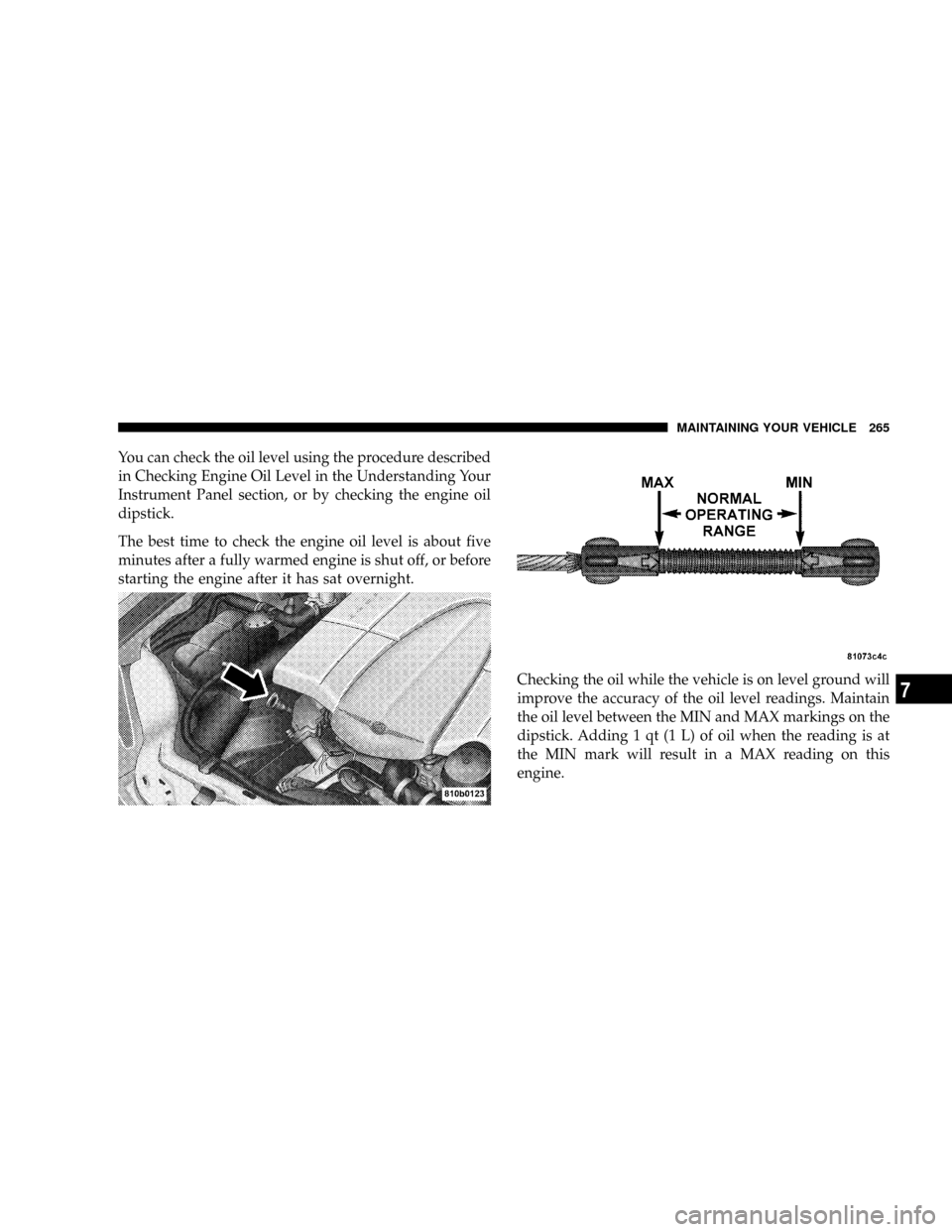
You can check the oil level using the procedure described
in Checking Engine Oil Level in the Understanding Your
Instrument Panel section, or by checking the engine oil
dipstick.
The best time to check the engine oil level is about five
minutes after a fully warmed engine is shut off, or before
starting the engine after it has sat overnight.
Checking the oil while the vehicle is on level ground will
improve the accuracy of the oil level readings. Maintain
the oil level between the MIN and MAX markings on the
dipstick. Adding 1 qt (1 L) of oil when the reading is at
the MIN mark will result in a MAX reading on this
engine.
MAINTAINING YOUR VEHICLE 265
7
Page 268 of 358
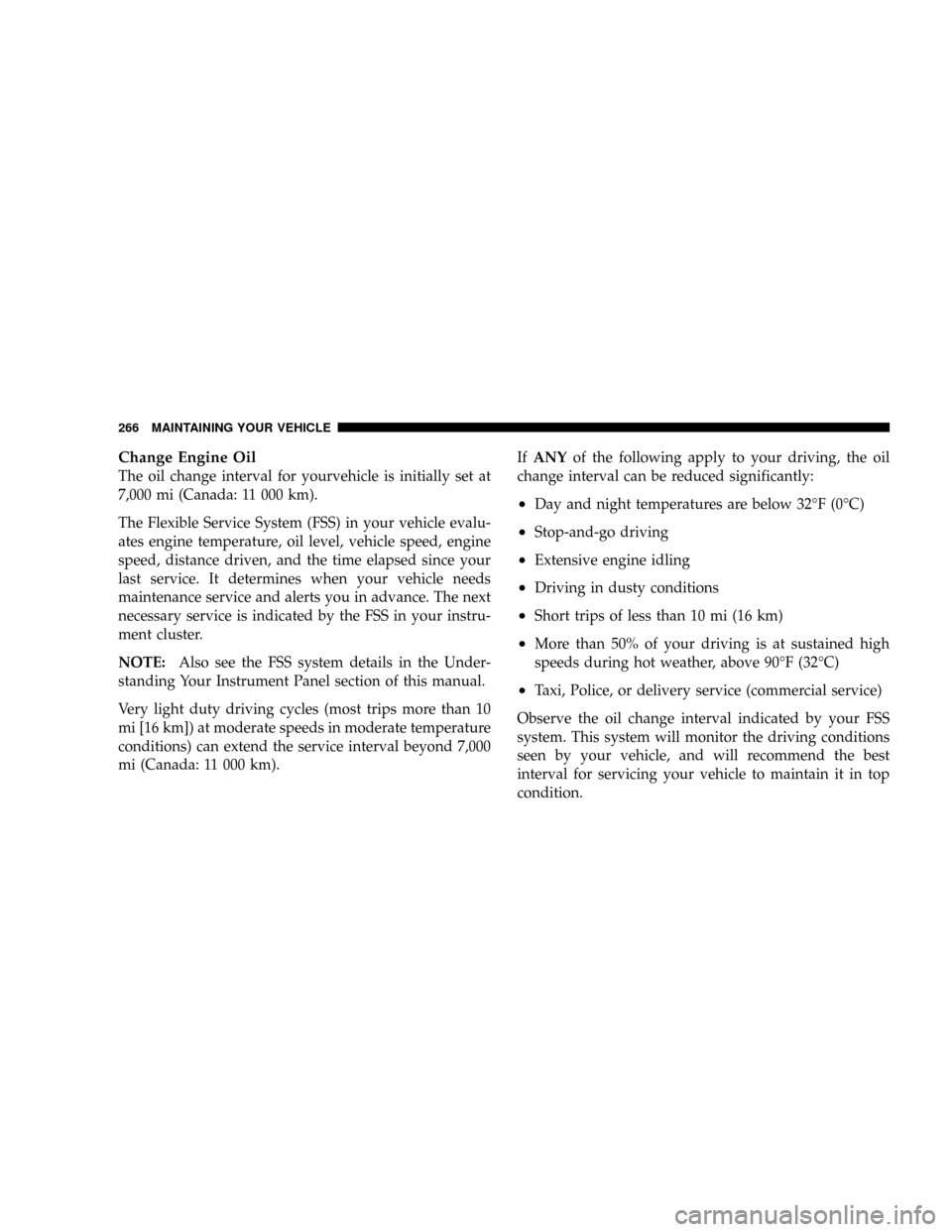
Change Engine Oil
The oil change interval for yourvehicle is initially set at
7,000 mi (Canada: 11 000 km).
The Flexible Service System (FSS) in your vehicle evalu-
ates engine temperature, oil level, vehicle speed, engine
speed, distance driven, and the time elapsed since your
last service. It determines when your vehicle needs
maintenance service and alerts you in advance. The next
necessary service is indicated by the FSS in your instru-
ment cluster.
NOTE:Also see the FSS system details in the Under-
standing Your Instrument Panel section of this manual.
Very light duty driving cycles (most trips more than 10
mi [16 km]) at moderate speeds in moderate temperature
conditions) can extend the service interval beyond 7,000
mi (Canada: 11 000 km).IfANYof the following apply to your driving, the oil
change interval can be reduced significantly:
²Day and night temperatures are below 32ÉF (0ÉC)
²Stop-and-go driving
²Extensive engine idling
²Driving in dusty conditions
²Short trips of less than 10 mi (16 km)
²More than 50% of your driving is at sustained high
speeds during hot weather, above 90ÉF (32ÉC)
²Taxi, Police, or delivery service (commercial service)
Observe the oil change interval indicated by your FSS
system. This system will monitor the driving conditions
seen by your vehicle, and will recommend the best
interval for servicing your vehicle to maintain it in top
condition.
266 MAINTAINING YOUR VEHICLE
Page 269 of 358
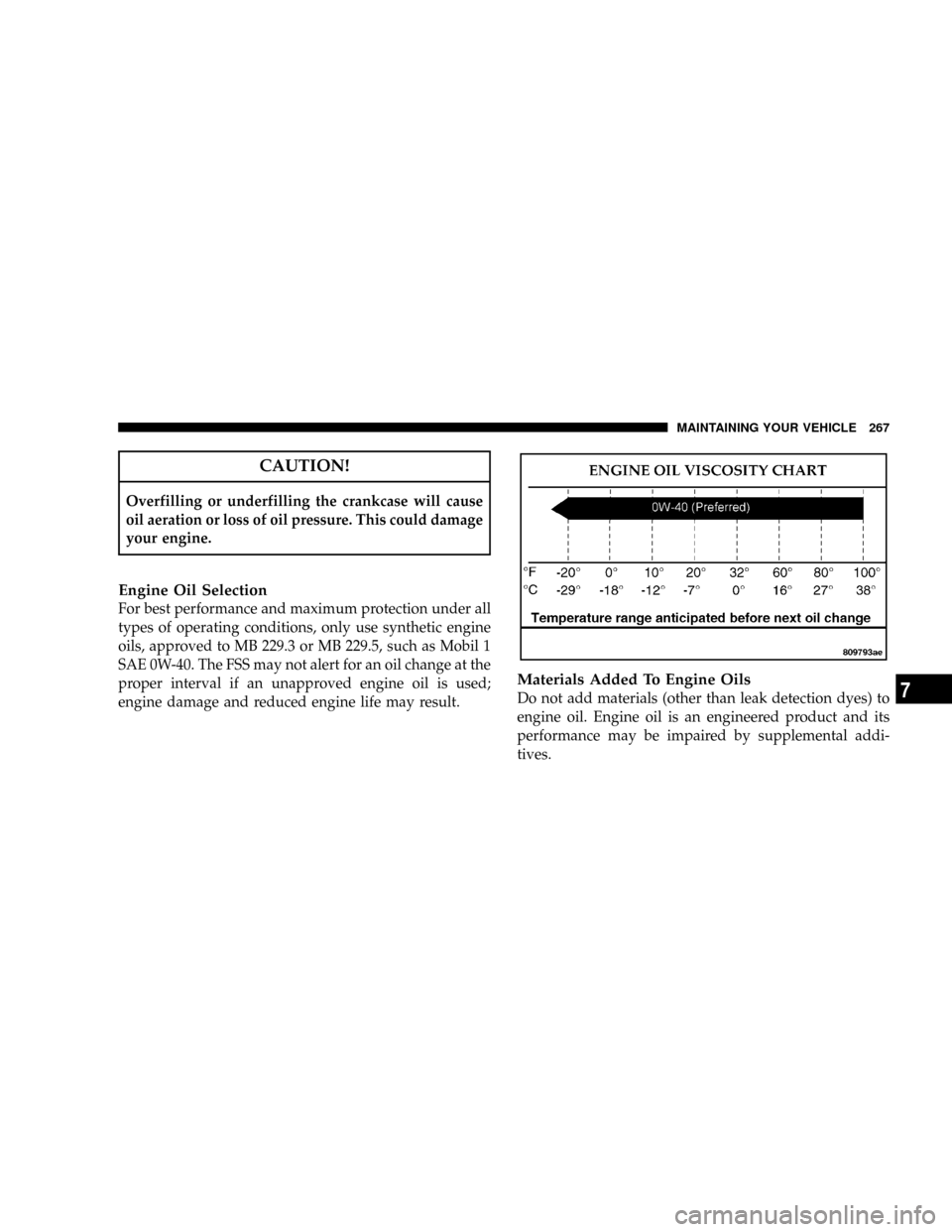
CAUTION!
Overfilling or underfilling the crankcase will cause
oil aeration or loss of oil pressure. This could damage
your engine.
Engine Oil Selection
For best performance and maximum protection under all
types of operating conditions, only use synthetic engine
oils, approved to MB 229.3 or MB 229.5, such as Mobil 1
SAE 0W-40. The FSS may not alert for an oil change at the
proper interval if an unapproved engine oil is used;
engine damage and reduced engine life may result.
Materials Added To Engine Oils
Do not add materials (other than leak detection dyes) to
engine oil. Engine oil is an engineered product and its
performance may be impaired by supplemental addi-
tives.
MAINTAINING YOUR VEHICLE 267
7
Page 270 of 358
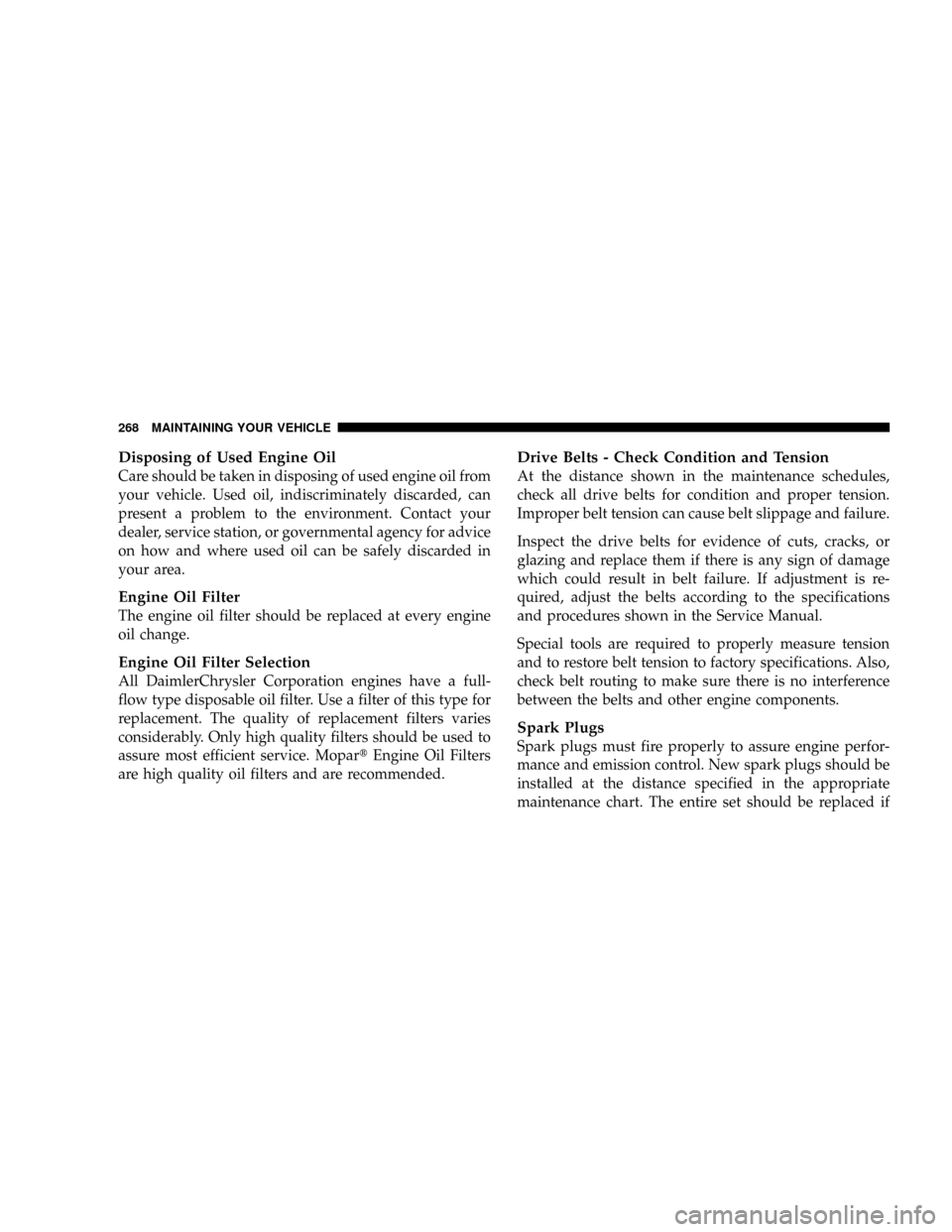
Disposing of Used Engine Oil
Care should be taken in disposing of used engine oil from
your vehicle. Used oil, indiscriminately discarded, can
present a problem to the environment. Contact your
dealer, service station, or governmental agency for advice
on how and where used oil can be safely discarded in
your area.
Engine Oil Filter
The engine oil filter should be replaced at every engine
oil change.
Engine Oil Filter Selection
All DaimlerChrysler Corporation engines have a full-
flow type disposable oil filter. Use a filter of this type for
replacement. The quality of replacement filters varies
considerably. Only high quality filters should be used to
assure most efficient service. MopartEngine Oil Filters
are high quality oil filters and are recommended.
Drive Belts - Check Condition and Tension
At the distance shown in the maintenance schedules,
check all drive belts for condition and proper tension.
Improper belt tension can cause belt slippage and failure.
Inspect the drive belts for evidence of cuts, cracks, or
glazing and replace them if there is any sign of damage
which could result in belt failure. If adjustment is re-
quired, adjust the belts according to the specifications
and procedures shown in the Service Manual.
Special tools are required to properly measure tension
and to restore belt tension to factory specifications. Also,
check belt routing to make sure there is no interference
between the belts and other engine components.
Spark Plugs
Spark plugs must fire properly to assure engine perfor-
mance and emission control. New spark plugs should be
installed at the distance specified in the appropriate
maintenance chart. The entire set should be replaced if
268 MAINTAINING YOUR VEHICLE